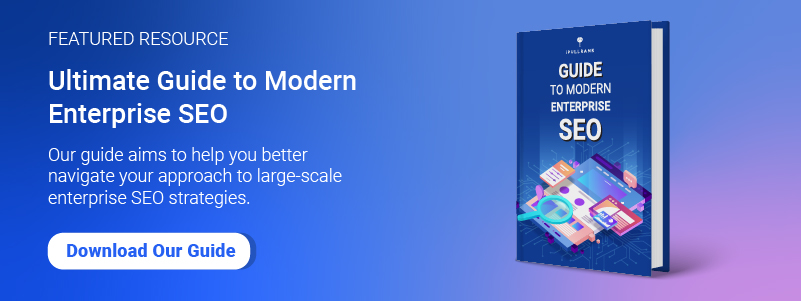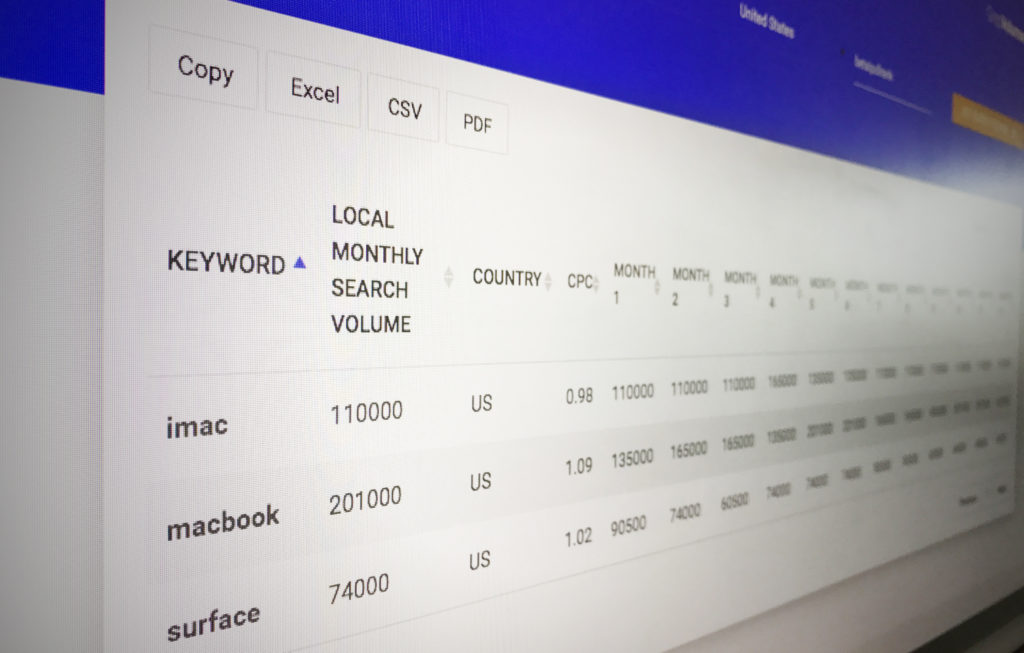Is your enterprise underperforming in search?
Maybe you’re a smaller, newer, or different company — one that doesn’t have the authority you need to perform well in search; perhaps you’re an established company that’s going through a major change or transition. As you’ll soon see, various issues can affect the authority of your enterprise negatively.
If you’re worried, E-A-T principles can give your enterprise a leg up.
Where do you start?
Today, we’ll look at 6 tactics you can use to improve your enterprise’s authority with Google.
Isn’t your enterprise authoritative already?
Enterprise brands are typically authoritative. That shouldn’t be a challenge for enterprise SEO, right?
They’re a large business, they have a large website or both. They have a proven track record, and they typically have a significant amount of brand trust and loyalty.
Isn’t this enough to establish authority?
It is, but it’s not enough.
There are a variety of factors that impact your brand’s authority. Here’s a brief look at a few of the issues that affect authority.
Challenge #1: Mergers and acquisitions
In 2013, Office Depot and Office Max merged to create the largest U.S. office supplies chain. Both companies had established brands, websites with a significant amount of domain authority and trustworthiness. Executives decided to keep both brands post-merger, a smart move given both brands’ strong presence in Google’s search results.
But it created an issue.
Which site do you keep, OfficeDepot.com or OfficeMax.com? Both have a significant amount of domain trust, rank well in Google, and perform well.
ODP decided to keep the Office Max brand but redirect content to the OfficeDepot.com domain. If we look at the OfficeMax.com domain on Open Site Explorer, we see:
As of today, OfficeMax.com is still producing. It’s been eight years, but there’s still authority and value here. It’s more reasonable to assume that the number for domain authority, linking domains, inbound links, and ranking keywords would be better immediately after the merger. Still, this domain is performing well almost a decade later.
What about OfficeDepot.com?
OfficeDepot.com is the money maker.
You see my point, though, right? Mergers and acquisitions complicate enterprise SEO. If you’re going to improve authority, these issues will need to be planned for pre-acquisition.
Challenge #2: New sites
When it comes to new sites, enterprises have an authority problem.
If we take a look at Google’s patent US8682892B1, Ranking Search Results, we see that they talk about “implied links.” Here’s what they had to say about those.
“A link for a group of resources is an incoming link to a resource in the group, i.e., a link having a resource in the group as its target. Links for the group can include express links, implied links, or both. An express link, e.g., a hyperlink, is a link that is included in a source resource that a user can follow to navigate to a target resource. An implied link is a reference to a target resource, e.g., a citation to the target resource, which is included in a source resource but is not an express link to the target resource. Thus, a resource in the group can be the target of an implied link without a user being able to navigate to the resource by following the implied link.”
What are they saying here?
Plain text mentions of your brand or business, with zero hyperlinks, are seen by Google as a type of backlink. New sites don’t have this kind of authority; they also don’t have the type of immediate trustworthiness that would produce inbound links.
That sort of thing takes time.
There are several helpful strategies enterprises can use to boost authority and trustworthiness, but it requires planning.
Challenge #3: Unknown individuals
Google wants to see that the authors on your site have the appropriate level of expertise.
Many brands focus their attention on the content, but they neglect the people behind the content. Many companies ask their employees, contractors, or professionals to create content but fail to display the expertise of their authors in a meaningful way that satisfies Google.
These issues are easy to resolve; more on this later.
Why E-A-T solves these problems
E-A-T is an acronym that stands for Expertise, Authoritativeness, and Trustworthiness. It first came on the scene in Google’s Search Quality Rater Guidelines.
Let’s break this down a bit.
- Expertise: Google wants to see that you’re very knowledgeable or skilled in a particular area. Google wants to see that you’re (a.) A subject matter expert with deep knowledge or proficiency in a specific area. (b.) You’re able to communicate that expertise in a way that’s simple, easy-to-understand, and appealing to searchers.
- Authoritativeness: It’s not enough that you’re a subject matter expert with deep knowledge or expertise. Google wants to see industry recognition — by other experts, thought leaders, or other well-known people and organizations in your space. What does this look like? Links and mentions from other authoritative sites with strong domain authority. You have a strong and recognizable brand, citations, or a Wikipedia page for your brand.
- Trustworthiness: This is all about your reputation; transparency is essential here. Lots of positive mentions online, a strong review portfolio, media mentions, author bios, clear product specifications, a clear privacy policy, and terms of use — these are all compelling examples that demonstrate trustworthiness.
High E-A-T content adheres to these guidelines, offering Google and searchers the helpful information they need.
Here’s why E-A-T is so important.
Google lists it as one of their most important page quality factors. E-A-T guidelines tell human reviewers, evaluating websites like yours, about the type of content Google considers high quality.
Here are the most important factors to consider when selecting an overall Page Quality rating:
- The Purpose of the Page
- Expertise, Authoritativeness, Trustworthiness: This is an important quality characteristic. Use your research on the additional factors below to inform your rating.
- Main Content Quality and Amount: The rating should be based on the landing page of the task URL.
- Website Information/information about who is responsible for the MC: Find information about the website and the creator of the MC.
- Website Reputation/reputation about who is responsible for the MC: Links to help with reputation research will be provided.
In their guide, Google states various types of “high E-A-T pages and websites.”
- High E-A-T medical content should be created by people and organizations with appropriate medical expertise, accreditation, and credentials. The consequences of low E-A-T content could have severe implications for readers, so this is essential. High E-A-T medical content is written in a professional style and edited, reviewed, and updated consistently.
- High E-A-T news content should be produced with journalistic rigor — adhering to journalism standards and ethics (e.g., factually accurate content presented in a way that amplifies reader understanding). High E-A-T news sources have publicly available editorial policies and review protocols, you know, like real journalists.
- High E-A-T information pages on scientific topics should be produced by people or organizations with the appropriate level and relevant scientific expertise. Google is looking for scientific consensus on issues where consensus exists; pseudoscience and fringe topics are generally frowned up.
- High E-A-T financial advice, legal advice, tax advice, etc., should come from competent, experienced, trustworthy sources. There are consequences to this type of content; disinformation or poor advice could be financially hazardous to readers. Financial content should be reviewed, maintained, and updated consistently.
- High E-A-T advice pages on topics such as home remodeling or advice on parenting issues should also come from “expert” or experienced sources that users can trust. Again, there’s a high cost for poor quality content, so authors must produce the right kind of content.
- High E-A-T pages on hobbies, such as photography or learning to play guitar, also require expertise. It’s not as rigorous as medical or financial content, but Google expects that you have the necessary knowledge to produce high-quality content.
As always, Google is focused on the user experience.
Is E-A-T really that important?
Absolutely.
According to Google, certain types of topics or content may potentially “impact a person’s future happiness, health, financial stability or safety. Google refers to these pages as “Your Money or Your Life” pages (YMYL).
Here are some examples of YMYL content:
- Civics government and law: This refers to content on a variety of pertinent topics — content on voting and elections (i.e., midterm elections), public institutions (i.e., the NIH or CDC), legal issues (e.g., creating a will, getting married or divorced, filing a lawsuit, etc.).
- Finance: This is a broad category that covers various topics — taxes, retirement, insurance, loans, mortgages, and investments.
- Health and safety: This covers all things medical, including healthcare, drugs, health insurance, the safety of an activity, treatment efficacy, and more.
- News, trending stories, and current events: This could refer to information on various topics, including business, politics, health, science, and technology.
- Shopping: This includes online shopping, including web pages that facilitate transactions, product research and specifications, and general product or service information.
- Groups of people: This refers to content that discusses groups of people, including content that’s grouped on the basis of age, caste, disability, ethnicity, gender identity and expression, immigration status, nationality, race, religion, sexual orientation, and more.
- Other: Other categories are included in Google’s YMYL; choosing a college, finding a job, buying a car, fitness, nutrition, etc.; Google has categories like these in YMYL if it impacts or is related to important decisions in people’s lives.
If your content touches on these categories, E-A-T is absolutely essential.
This makes sense.
Many of these categories have a life or death impact; disinformation comes with very real, very severe consequences. Google’s focus is on the user, so disinformation is not something they’re willing to accept if they can help it.
Why E-A-T matters to the enterprise
When we use the word “enterprise,” what are we referring to specifically?
We use the word enterprise in an SEO context. We’re talking about companies that meet at least one of these three distinct criteria:
- Large websites: These websites have pages in the thousands or millions and are typically owned by a large corporation.
- Significant reach: Websites like Costco, Target, or HP serve national and international markets. These are established brands serving millions of people.
- Brand recognition: Lowe’s, Allstate, or BMW have strong and significant brand recognition. These companies are viewed as industry leaders and authoritative sources.
So why does E-A-T matter to the enterprise?
Google published the first version of their Search Quality Rater Guidelines in 2013; they wanted to “help webmasters understand what Google looks for in a webpage.”
Why would they do that?
Because, as Eric Schmidt pointed out, brands are the solution.
“Brands are the solution, not the problem. That’s how you organize the cesspool. In a world of no constraints, where anyone can publish anything, brand affinity is clearly high-wired. It’s so fundamental to human existence it’s not going to go away. How else would you organize society?”
E-A-T is the legend, the guide that shows you how to establish your enterprise as a site that provides searchers with high E-A-T content. The better you demonstrate your expertise and credibility, the easier it is for your brand to benefit from Google’s search results.
It’s the clear path to better rankings, more visibility, traffic, and revenue.
This sounds hard.
It sounds like you will have to move mountains if you want to create high E-A-T content. If you’re like most marketing teams, you’re already doing everything you can to keep up with the never-ending flow of work that needs to be done.
Here’s the good news.
Google’s ranking factors can be segmented into four categories.
- Content that’s aligned with E-A-T
- Technical aspects — page speed, interlinking, subdomain best practices, etc.
- Site authority, this includes negative SEO, online reviews, inbound links, etc.
- Page experience
Let’s shift our focus to improving site authority using E-A-T; here are six strategies you can use to do just that.
Improving authority with E-A-T
Here are a few tactics you can use to improve authority via E-A-T. These tactics, when sued, will boost your enterprise’s authority and trustworthiness over time.
Tactic #1: Audit your external links to make sure they are authoritative
Start with an audit of your external links.
You’ll want to verify that the external links pointing to your site are aligned with E-A-T. Your external link profile should consist of trusted, relevant, authoritative links. If it’s questionable or spammy, disavow. High external links mean better-performing content.
When link building, make sure your high-value content links to less valuable content.
Tactic #2: Remove spam comments from your site
This is low-hanging fruit.
If we look at Google’s feedback on comment spam, we can see that they view it as problematic. That’s important because they’re also pretty clear about the consequences of rampant comment spam on your site.
Take a look.
The strategies for combatting comment spam are straightforward.
- Turn on comment and profile moderation
- Use anti-spam tools like Akismet or Disqus to combat spam
- Use the nofollow attribute or more specific attributes
- Have the appropriate teams moderate your content
- Close content after a designated period of time
Tactic #3: Conduct reputation research with a goal to eliminate negative SEO
Negative SEO could be due to blackhats, disgruntled customers, or unethical competitors.
The tactics used vary, but the goal is the same; damaging your site. If you’re the victim of negative SEO, you may find that your rankings decrease dramatically, portions (or all) of your site are de-indexed, and you’re now flooded with spammy links and fake reviews.
Identify these challenges ahead of time.
Use tools like Google Search Console, Ahrefs, or SEMrush to analyze your backlinks. Go through and disavow any unsavory links that you find.
Next, work to create high-quality content to replace the content you’ve just disavowed. You can request reviews from your customers, build links to quality pages, and create content that’s helpful and follows E-A-T principles.
Tactic #4: Include author details for all blog content
Author authority builds relationships and brand trust. This doesn’t seem like an important detail until you add context.
Option A: Your organization offers investment and financial advice on the blog. It’s great content, but it’s not clear who wrote it or when. It seems like it could work, though.
Option B: Your organization offers investment and financial advice. Rich writes it, a financial advisor who specializes in the tactics he’s mentioned. He shares his credentials, expertise, and years of experience. You can see his LinkedIn profile, the number of articles he’s written, his Twitter and Facebook profiles.
Which one would you contact?
See what I mean?
Whether you use employees or you reach out to freelance professionals, you’ll want to offer up their credentials and expertise. Do the work to build your team’s credibility, and your author’s authority improves naturally.
Tactic #5:Build authority for key figures in your enterprise
Tony Hsieh, former CEO of Zappos, built a persona and authority around his personal brand. As a key figure in Zappos, he wrote books and created content oriented around his entrepreneurial endeavors.
He created content that evangelized Zappos as a company and the “holacracy” and self-directed culture he created at Zappos.
You can do the same.
Lean on key figures in your enterprise; have them create specialized content aligned with or tangential to the organization’s goals. Promote their content on your website and across your social media platforms. Then branch out as you’re able.
Building author authority is a sure-fire way to improve site-wide authority.
Tactic #6: Remove or update poor content
Your old content may be hurting your site’s authority.
Most of the content that’s published is noise. If you’re going to continue to improve your organization’s authority, you’ll want to make sure that you’re providing Google with your best, 10x content, the kind of content that’s sure to please visitors.
This means you’ll need to remove or update poor-performing content.
You’ll want to audit your content and identify the pieces that are producing consistent results, content that doesn’t move the needle in a meaningful way, and harmful content — duplicate content, soft 404s, orphan pages, etc.
Remove pages that are hurting performance or are unlikely to rank from your crawl budget. Update neutral or positive content that’s producing results; you’ll want to make sure that your content is current, accurate, and aligned with E-A-T.
Use E-A-T to boost authority in your enterprise
Brands are the solution.
E-A-T helps human reviewers evaluate websites like yours, providing Google with the content they consider high quality. It’s an essential part of SEO and content marketing.
E-A-T is the legend, the guide that shows you how to establish your enterprise as a site that provides searchers with high E-A-T content. The better you demonstrate your expertise and credibility, the easier it is for your brand to benefit from Google’s search results.
It’s the clear path your enterprise needs to better rankings, more traffic, and more revenue.
- The Cost of SEO Services in 2024 - January 4, 2024
- The 2024 SEO Guide To Successful Website Migration - April 4, 2023
- How Audience Research Shapes Financial Services Marketing - February 16, 2023












Leave a Comment